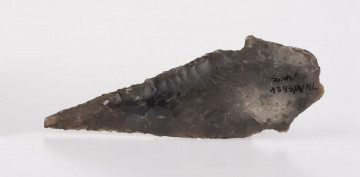
Arrowhead
National Museum in Lublin
Part of the collection: Set of archaeological relics found in the Lublin Region
In 1975 in the town of Bielsko (Opole poviat) archaeologists from the Lublin Museum conducted excavations in a bronze-age cremation cemetery. Owning to the monuments discovered there, it was possible to determine who buried their dead there. These were the people of the Lusatian culture, who lived in the area of today's Bielsko about 3,000 years ago.
During the research of the former cemetery, archaeologists discovered nearly one hundred burials. Researchers unearthed many interesting items both in the tombs and between them. Among them there is a bronze arrowhead.
This arrowhead undoubtedly served as the sharp end of an arrow for a bow. It is an interesting find because the people of the Lusatian culture in the present-day Lublin region rarely used bronze objects. Other raw materials for the manufacture of tools and weapons, including arrowheads, were used much more often. Flint dominated among them, and bone pointed heads were also present.
The method of making old arrows is also interesting. In their production resin was usually used, which served as the glue connecting the point with the shaft of the arrow.
And since when did people use the bow?
Our knowledge changes with new discoveries. Currently, stone monuments from cave sites in South Africa are considered to be the oldest arrowheads. They are dated back to around 70,000 years (and thus, the arc has been used since then). The archaeological finds are much younger - they are around 9,000 years old and come from Danish peat bogs in Holmegård.
Author / creator
Dimensions
cały obiekt: height: 1,8 cm, width: 3,2 cm
Object type
weapon
Technique
cast
Material
bronze
Creation / finding place
Owner
The National Museum in Lublin
Identification number
Location / status